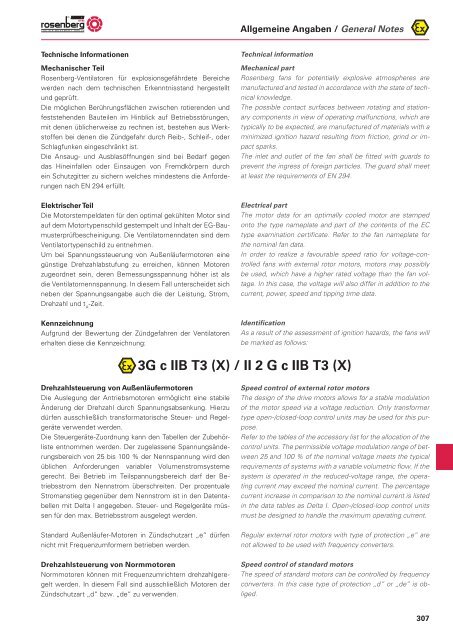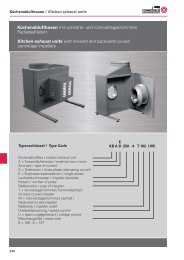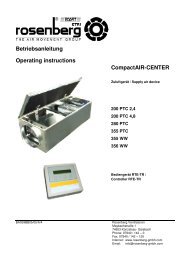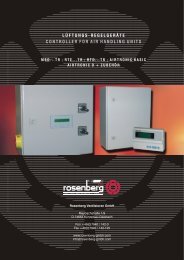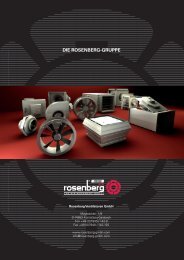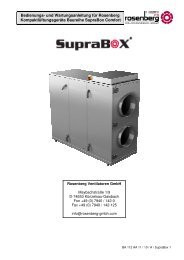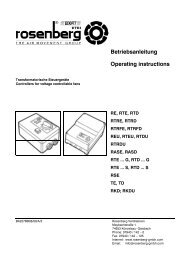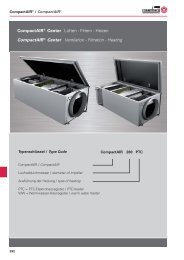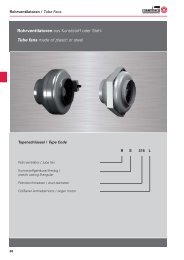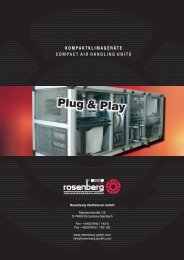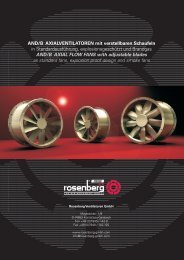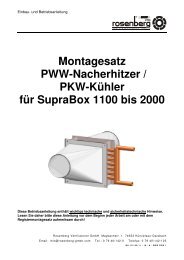3G c IIB T3 (X) / II 2 G c IIB T3 (X) - Rosenberg Ventilatoren GmbH
3G c IIB T3 (X) / II 2 G c IIB T3 (X) - Rosenberg Ventilatoren GmbH
3G c IIB T3 (X) / II 2 G c IIB T3 (X) - Rosenberg Ventilatoren GmbH
You also want an ePaper? Increase the reach of your titles
YUMPU automatically turns print PDFs into web optimized ePapers that Google loves.
Technische Informationen Technical information<br />
Mechanischer Teil<br />
<strong>Rosenberg</strong>-<strong>Ventilatoren</strong> für explosionsgefährdete Bereiche<br />
werden nach dem technischen Erkenntnisstand hergestellt<br />
und geprüft.<br />
Die möglichen Berührungsflächen zwischen rotierenden und<br />
feststehenden Bauteilen im Hinblick auf Betriebsstörungen,<br />
mit denen üblicherweise zu rechnen ist, bestehen aus Werkstoffen<br />
bei denen die Zündgefahr durch Reib-, Schleif-, oder<br />
Schlagfunken eingeschränkt ist.<br />
Die Ansaug- und Ausblasöffnungen sind bei Bedarf gegen<br />
das Hineinfallen oder Einsaugen von Fremdkörpern durch<br />
ein Schutzgitter zu sichern welches mindestens die Anforderungen<br />
nach EN 294 erfüllt.<br />
Elektrischer Teil<br />
Die Motorstempeldaten für den optimal gekühlten Motor sind<br />
auf dem Motortypenschild gestempelt und Inhalt der EG-Baumusterprüfbescheinigung.<br />
Die Ventilatornenndaten sind dem<br />
Ventilatortypenschild zu entnehmen.<br />
Um bei Spannungssteuerung von Außenläufermotoren eine<br />
günstige Drehzahlabstufung zu erreichen, können Motoren<br />
zugeordnet sein, deren Bemessungsspannung höher ist als<br />
die Ventilatornennspannung. In diesem Fall unterscheidet sich<br />
neben der Spannungsangabe auch die der Leistung, Strom,<br />
Drehzahl und t A -Zeit.<br />
Kennzeichnung<br />
Aufgrund der Bewertung der Zündgefahren der <strong>Ventilatoren</strong><br />
erhalten diese die Kennzeichnung:<br />
Drehzahlsteuerung von Außenläufermotoren<br />
Die Auslegung der Antriebsmotoren ermöglicht eine stabile<br />
Änderung der Drehzahl durch Spannungsabsenkung. Hierzu<br />
dürfen ausschließlich transformatorische Steuer- und Regelgeräte<br />
verwendet werden.<br />
Die Steuergeräte-Zuordnung kann den Tabellen der Zubehörliste<br />
entnommen werden. Der zugelassene Spannungsänderungsbereich<br />
von 25 bis 100 % der Nennspannung wird den<br />
üblichen Anforderungen variabler Volumenstromsysteme<br />
gerecht. Bei Betrieb im Teilspannungsbereich darf der Betriebsstrom<br />
den Nennstrom überschreiten. Der prozentuale<br />
Stromanstieg gegenüber dem Nennstrom ist in den Datentabellen<br />
mit Delta I angegeben. Steuer- und Regelgeräte müssen<br />
für den max. Betriebsstrom ausgelegt werden.<br />
Standard Außenläufer-Motoren in Zündschutzart „e“ dürfen<br />
nicht mit Frequenzumformern betrieben werden.<br />
Drehzahlsteuerung von Normmotoren<br />
Normmotoren können mit Frequenzumrichtern drehzahlgeregelt<br />
werden. In diesem Fall sind ausschließlich Motoren der<br />
Zündschutzart „d“ bzw. „de“ zu verwenden.<br />
Allgemeine Angaben / General Notes<br />
Mechanical part<br />
<strong>Rosenberg</strong> fans for potentially explosive atmospheres are<br />
manufactured and tested in accordance with the state of technical<br />
knowledge.<br />
The possible contact surfaces between rotating and stationary<br />
components in view of operating malfunctions, which are<br />
typically to be expected, are manufactured of materials with a<br />
minimized ignition hazard resulting from friction, grind or impact<br />
sparks.<br />
The inlet and outlet of the fan shall be fitted with guards to<br />
prevent the ingress of foreign particles. The guard shall meet<br />
at least the requirements of EN 294.<br />
Electrical part<br />
The motor data for an optimally cooled motor are stamped<br />
onto the type nameplate and part of the contents of the EC<br />
type examination certificate. Refer to the fan nameplate for<br />
the nominal fan data.<br />
In order to realize a favourable speed ratio for voltage-controlled<br />
fans with external rotor motors, motors may possibly<br />
be used, which have a higher rated voltage than the fan voltage.<br />
In this case, the voltage will also differ in addition to the<br />
current, power, speed and tipping time data.<br />
Identification<br />
As a result of the assessment of ignition hazards, the fans will<br />
be marked as follows:<br />
<strong>3G</strong> c <strong><strong>II</strong>B</strong> <strong>T3</strong> (X) / <strong>II</strong> 2 G c <strong><strong>II</strong>B</strong> <strong>T3</strong> (X)<br />
Speed control of external rotor motors<br />
The design of the drive motors allows for a stable modulation<br />
of the motor speed via a voltage reduction. Only transformer<br />
type open-/closed-loop control units may be used for this purpose.<br />
Refer to the tables of the accessory list for the allocation of the<br />
control units. The permissible voltage modulation range of between<br />
25 and 100 % of the nominal voltage meets the typical<br />
requirements of systems with a variable volumetric flow. If the<br />
system is operated in the reduced-voltage range, the operating<br />
current may exceed the nominal current. The percentage<br />
current increase in comparison to the nominal current is listed<br />
in the data tables as Delta I. Open-/closed-loop control units<br />
must be designed to handle the maximum operating current.<br />
Regular external rotor motors with type of protection „e“ are<br />
not allowed to be used with frequency converters.<br />
Speed control of standard motors<br />
The speed of standard motors can be controlled by frequency<br />
converters. In this case type of protection „d“ or „de“ is obliged.<br />
307


